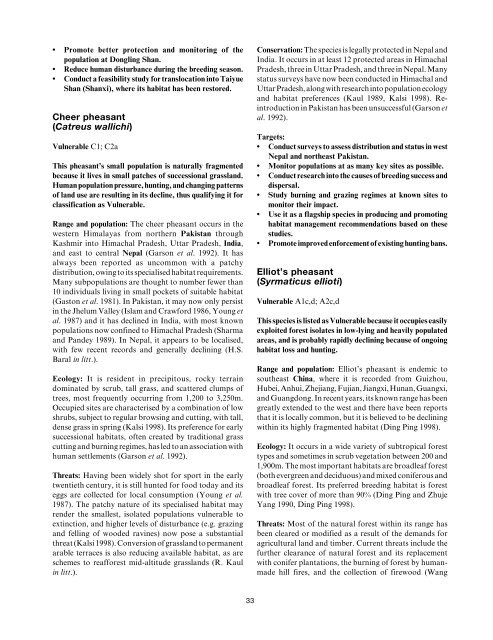Pheasants: Status Survey and Conservation Action Plan ... - IUCN
Pheasants: Status Survey and Conservation Action Plan ... - IUCN
Pheasants: Status Survey and Conservation Action Plan ... - IUCN
Create successful ePaper yourself
Turn your PDF publications into a flip-book with our unique Google optimized e-Paper software.
• Promote better protection <strong>and</strong> monitoring of the<br />
population at Dongling Shan.<br />
• Reduce human disturbance during the breeding season.<br />
• Conduct a feasibility study for translocation into Taiyue<br />
Shan (Shanxi), where its habitat has been restored.<br />
Cheer pheasant<br />
(Catreus wallichi)<br />
Vulnerable C1; C2a<br />
This pheasant’s small population is naturally fragmented<br />
because it lives in small patches of successional grassl<strong>and</strong>.<br />
Human population pressure, hunting, <strong>and</strong> changing patterns<br />
of l<strong>and</strong> use are resulting in its decline, thus qualifying it for<br />
classification as Vulnerable.<br />
Range <strong>and</strong> population: The cheer pheasant occurs in the<br />
western Himalayas from northern Pakistan through<br />
Kashmir into Himachal Pradesh, Uttar Pradesh, India,<br />
<strong>and</strong> east to central Nepal (Garson et al. 1992). It has<br />
always been reported as uncommon with a patchy<br />
distribution, owing to its specialised habitat requirements.<br />
Many subpopulations are thought to number fewer than<br />
10 individuals living in small pockets of suitable habitat<br />
(Gaston et al. 1981). In Pakistan, it may now only persist<br />
in the Jhelum Valley (Islam <strong>and</strong> Crawford 1986, Young et<br />
al. 1987) <strong>and</strong> it has declined in India, with most known<br />
populations now confined to Himachal Pradesh (Sharma<br />
<strong>and</strong> P<strong>and</strong>ey 1989). In Nepal, it appears to be localised,<br />
with few recent records <strong>and</strong> generally declining (H.S.<br />
Baral in litt.).<br />
Ecology: It is resident in precipitous, rocky terrain<br />
dominated by scrub, tall grass, <strong>and</strong> scattered clumps of<br />
trees, most frequently occurring from 1,200 to 3,250m.<br />
Occupied sites are characterised by a combination of low<br />
shrubs, subject to regular browsing <strong>and</strong> cutting, with tall,<br />
dense grass in spring (Kalsi 1998). Its preference for early<br />
successional habitats, often created by traditional grass<br />
cutting <strong>and</strong> burning regimes, has led to an association with<br />
human settlements (Garson et al. 1992).<br />
Threats: Having been widely shot for sport in the early<br />
twentieth century, it is still hunted for food today <strong>and</strong> its<br />
eggs are collected for local consumption (Young et al.<br />
1987). The patchy nature of its specialised habitat may<br />
render the smallest, isolated populations vulnerable to<br />
extinction, <strong>and</strong> higher levels of disturbance (e.g. grazing<br />
<strong>and</strong> felling of wooded ravines) now pose a substantial<br />
threat (Kalsi 1998). Conversion of grassl<strong>and</strong> to permanent<br />
arable terraces is also reducing available habitat, as are<br />
schemes to reafforest mid-altitude grassl<strong>and</strong>s (R. Kaul<br />
in litt.).<br />
<strong>Conservation</strong>: The species is legally protected in Nepal <strong>and</strong><br />
India. It occurs in at least 12 protected areas in Himachal<br />
Pradesh, three in Uttar Pradesh, <strong>and</strong> three in Nepal. Many<br />
status surveys have now been conducted in Himachal <strong>and</strong><br />
Uttar Pradesh, along with research into population ecology<br />
<strong>and</strong> habitat preferences (Kaul 1989, Kalsi 1998). Reintroduction<br />
in Pakistan has been unsuccessful (Garson et<br />
al. 1992).<br />
Targets:<br />
• Conduct surveys to assess distribution <strong>and</strong> status in west<br />
Nepal <strong>and</strong> northeast Pakistan.<br />
• Monitor populations at as many key sites as possible.<br />
• Conduct research into the causes of breeding success <strong>and</strong><br />
dispersal.<br />
• Study burning <strong>and</strong> grazing regimes at known sites to<br />
monitor their impact.<br />
• Use it as a flagship species in producing <strong>and</strong> promoting<br />
habitat management recommendations based on these<br />
studies.<br />
• Promote improved enforcement of existing hunting bans.<br />
Elliot’s pheasant<br />
(Syrmaticus ellioti)<br />
Vulnerable A1c,d; A2c,d<br />
This species is listed as Vulnerable because it occupies easily<br />
exploited forest isolates in low-lying <strong>and</strong> heavily populated<br />
areas, <strong>and</strong> is probably rapidly declining because of ongoing<br />
habitat loss <strong>and</strong> hunting.<br />
Range <strong>and</strong> population: Elliot’s pheasant is endemic to<br />
southeast China, where it is recorded from Guizhou,<br />
Hubei, Anhui, Zhejiang, Fujian, Jiangxi, Hunan, Guangxi,<br />
<strong>and</strong> Guangdong. In recent years, its known range has been<br />
greatly extended to the west <strong>and</strong> there have been reports<br />
that it is locally common, but it is believed to be declining<br />
within its highly fragmented habitat (Ding Ping 1998).<br />
Ecology: It occurs in a wide variety of subtropical forest<br />
types <strong>and</strong> sometimes in scrub vegetation between 200 <strong>and</strong><br />
1,900m. The most important habitats are broadleaf forest<br />
(both evergreen <strong>and</strong> deciduous) <strong>and</strong> mixed coniferous <strong>and</strong><br />
broadleaf forest. Its preferred breeding habitat is forest<br />
with tree cover of more than 90% (Ding Ping <strong>and</strong> Zhuje<br />
Yang 1990, Ding Ping 1998).<br />
Threats: Most of the natural forest within its range has<br />
been cleared or modified as a result of the dem<strong>and</strong>s for<br />
agricultural l<strong>and</strong> <strong>and</strong> timber. Current threats include the<br />
further clearance of natural forest <strong>and</strong> its replacement<br />
with conifer plantations, the burning of forest by humanmade<br />
hill fires, <strong>and</strong> the collection of firewood (Wang<br />
33
















